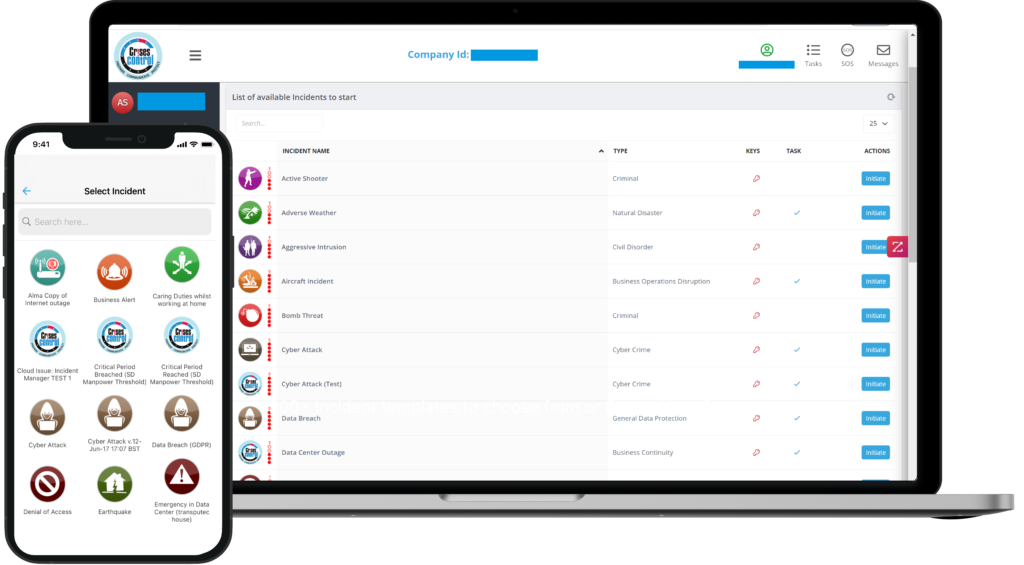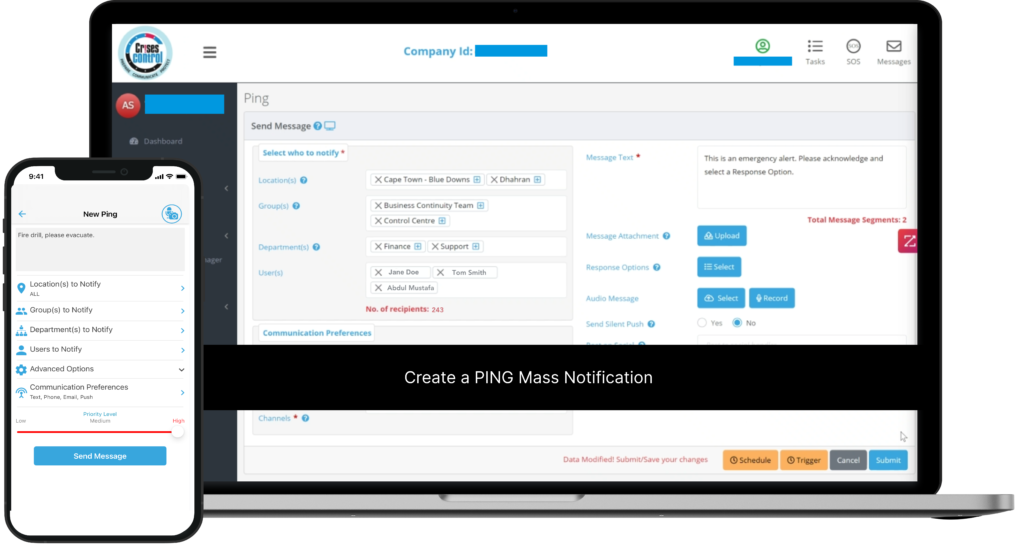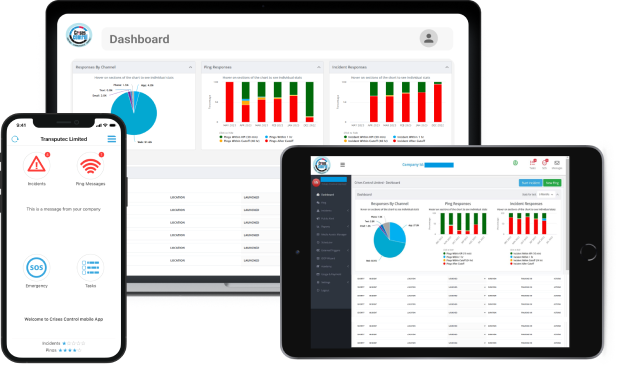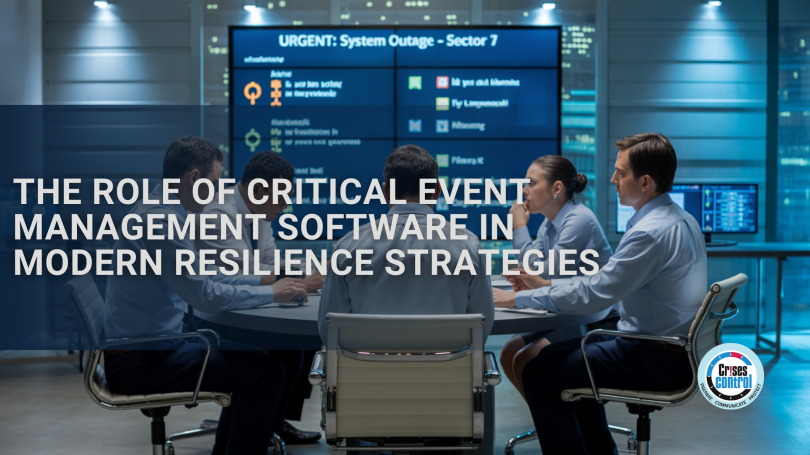Written by Anneri Fourie | Crises Control Executive
The Problem with Traditional Crisis Response
Imagine a situation where a sudden cyber-attack cripples your IT systems, or a natural disaster disrupts your supply chain. How quickly can you react? If your organisation relies on old, manual processes, sending out emails, making phone calls, or checking spreadsheets to coordinate a response, you might already be too late.
The truth is, traditional crisis response systems are no longer up to the task. In a world where events can escalate in a matter of minutes, relying on outdated methods for emergency communication and coordination can cost you time, money, and even reputation.
This is where Critical Event Management Software (CEMS) comes in. It automates crisis response, helping organisations respond faster, more effectively, and with far fewer errors. But how does it work, and why is it so important? Let’s take a closer look.
What Is Critical Event Management Software and How Does It Work?
Critical Event Management Software is a digital platform that helps organisations deal with emergencies. Whether it’s a cyber breach, a natural disaster, or even something like a fire alarm going off, CEMS integrates all the necessary tools to manage a crisis in one place. It automates the steps needed to respond quickly and effectively, from alerts to recovery, so your team can focus on solving the problem rather than scrambling to manage it.
Core features of CEMS typically include:
- Emergency Notification Systems: Sending alerts across multiple channels—text, email, phone calls, or internal chat systems like Microsoft Teams.
- Risk Intelligence Integrations: Pulling in data from external sources to spot threats before they become critical.
- Workflow Automation: Automatically triggering response protocols based on the severity of an event.
- Real-time Dashboards: Providing situational awareness to your crisis team so everyone knows what’s happening and what to do.
- Audit Trails and Reporting: Keeping records for compliance and post-incident reviews.
In short, CEMS helps you prepare for, manage, and recover from critical events, all without needing to manage each individual step manually. It’s a game-changer for businesses that need to act quickly and efficiently in times of crisis.
Why Traditional Crisis Response No Longer Works for Large Organisations
In large organisations, the challenges are magnified. Dispersed teams, complex communication chains, strict compliance rules, and an increasing number of threats all combine to make a crisis response incredibly difficult. Traditional methods—email chains, phone trees, and manual checklists—are too slow to keep up with the speed at which problems can escalate today.
The risks are not just operational, they’re financial, reputational, and even legal. By the time a critical decision is made or an action is taken, the damage could already be done. Automation with CEMS ensures that no one is left out of the loop, and critical tasks are completed without delay.
Here’s how automation through Critical Event Management Software improves crisis response in large organisations:
- Speed: It cuts down response time from minutes or hours to seconds.
- Reach: Ensures that all stakeholders are notified, regardless of their location or role.
- Accuracy: Provides role-based instructions to responders, ensuring they do exactly what’s needed.
- Accountability: Every action taken during the crisis is logged, which aids in compliance and post-crisis reviews.
For large teams facing high-stakes incidents, every second matters. Automation ensures that the clock is working in your favour.
How to Automate Crisis Response in Large Organisations
Automation isn’t just about purchasing software, it’s about setting up an intelligent system that works for your specific needs. Here’s how Crises Control makes this possible:
Risk Mapping and Scenario Planning
You begin by identifying the types of events most likely to disrupt your operations. Whether it’s an IT system failure, a supply chain breakdown, or a fire, Crises Control helps you map these risks and plan responses accordingly.
Custom Workflow Configuration
Every crisis requires a different response. Crises Control allows you to design workflows tailored to specific events, automatically triggering actions like alerting response teams, notifying stakeholders, or escalating the issue if necessary.
Multi-Channel Emergency Notification Systems
Alerts are sent through multiple channels—SMS, push notifications, emails, or phone calls, so you can reach your people no matter where they are.
Real-Time Emergency Alerts with Automation
Automated alerts don’t just notify people, they can also trigger predefined actions. For example, if sensors detect a fire, Crises Control can automatically notify the relevant personnel and begin evacuation protocols.
Post-Incident Reviews and Compliance
After the event, every action is logged, making it easier to review how the crisis was handled, identify any gaps in the response, and ensure compliance with industry regulations.
This automated, holistic approach means that your crisis response system is not only fast, but also smart and repeatable. You can rely on it for any incident, big or small.

Interested in our Incident Management Software?
Customise your Crisis Incident Management Software to meet your specific needs with our flexible tools & stay connected and informed during the crisis and incident management process
Benefits of Critical Event Management Software for Business Continuity Planning
Business Continuity Planning (BCP) is all about ensuring your organisation can keep running—or quickly get back on its feet—during and after a crisis. Traditional BCP plans often consist of static documents that require manual updates and don’t account for the real-time challenges of a crisis.
With Critical Event Management Software (CEMS), BCP becomes dynamic, flexible, and scalable:
- Dynamic Plan Activation: Instead of relying on a PDF document that might be outdated or hard to find, CEMS embeds response plans in the system. These plans are automatically activated when an event occurs, ensuring a faster, more efficient response.
- Scalable Response: Whether it’s a localised issue or a global crisis, CEMS adapts to the scale of the event, scaling your communication and coordination as needed.
- Regulatory Compliance: In highly regulated industries like finance or healthcare, compliance is a key concern. CEMS helps you meet audit requirements by automatically recording and storing actions taken during the crisis.
- Operational Resilience: By reducing downtime and confusion, CEMS ensures that critical functions continue or are restored quickly, helping your business stay operational even under the most difficult circumstances.
With Crises Control, business continuity becomes less about reactive recovery and more about proactive resilience.
Streamlining Emergency Alerts for Faster, Smarter Crisis Response
In many organisations, crisis response still relies heavily on manual steps. Someone notices an issue, raises the alarm, and starts informing others. But during fast-moving events, delays like these can cost time, money, and even lives.
Crises Control streamlines this process by enabling real-time emergency alerts and instant activation of predefined response plans. Here’s how it works:
- Role-Based Notifications: Alerts are customised based on the recipient’s role, so each person receives instructions relevant to their responsibilities. A facilities manager, for instance, might get different guidance than someone in IT or senior leadership.
- Two-Way Communication: The platform doesn’t just send messages—it can collect responses too. You can track who’s safe, who’s responded, and what actions are underway, all in real time.
- Message Cascading Across Channels: Alerts are sent across multiple communication channels—including SMS, email, phone calls, and mobile push notifications—in a cascading sequence. If a message isn’t acknowledged on one channel, the system will retry using others, increasing the likelihood of reaching the right people fast.
By simplifying and strengthening the alerting process, Crises Control helps organisations shift from fragmented, reactive response to coordinated, proactive action.
How Crises Control Helps You Stay Ahead of the Next Crisis
Crises Control isn’t just a tool for responding to crises, it’s a long-term resilience partner. Here’s how we stand apart:
- Flexible Deployment Options: Crises Control fits seamlessly into your existing IT setup and offers secure cloud hosting to support your resilience goals.
- 24/7 Support: Our team is available round the clock, ensuring that your crisis response strategy stays intact even outside of business hours.
- Integration Ready: Crises Control can integrate seamlessly with the systems you already use, such as HR databases, physical access systems, or monitoring tools.
- Enterprise-Grade Security: With ISO 27001 certification and GDPR compliance, Crises Control is built to handle sensitive data securely.
- Multi-Language Support: Our platform supports multiple languages, including English, Polish, Turkish, Arabic, Italian, and Spanish, ensuring clear communication across your global workforce during any crisis.
Crises Control is trusted by governments, financial institutions, healthcare providers, and large enterprises to manage everything from IT failures to natural disasters.
Interested in our Ping Mass Notification Platform?
Efficiently alert everyone in seconds at scale with our Mass Notification Platform – PING, get the message out fast and ensure rapid response and recovery.

Conclusion: Building Resilience Through Automation—Start Today
The future of crisis management is clear: it’s faster, smarter, and more automated. With threats becoming more unpredictable and complex, relying on outdated methods is no longer an option.
Critical Event Management Software offers a smarter, faster, and more reliable way to protect your people, operations, and reputation. And Crises Control is leading the charge, making this solution scalable and accessible to organisations of all sizes.
Don’t wait for the next crisis to show you where your weaknesses are.
Contact us today to schedule your free demo and see how Crises Control can transform your crisis response strategy.
Request a FREE Demo

